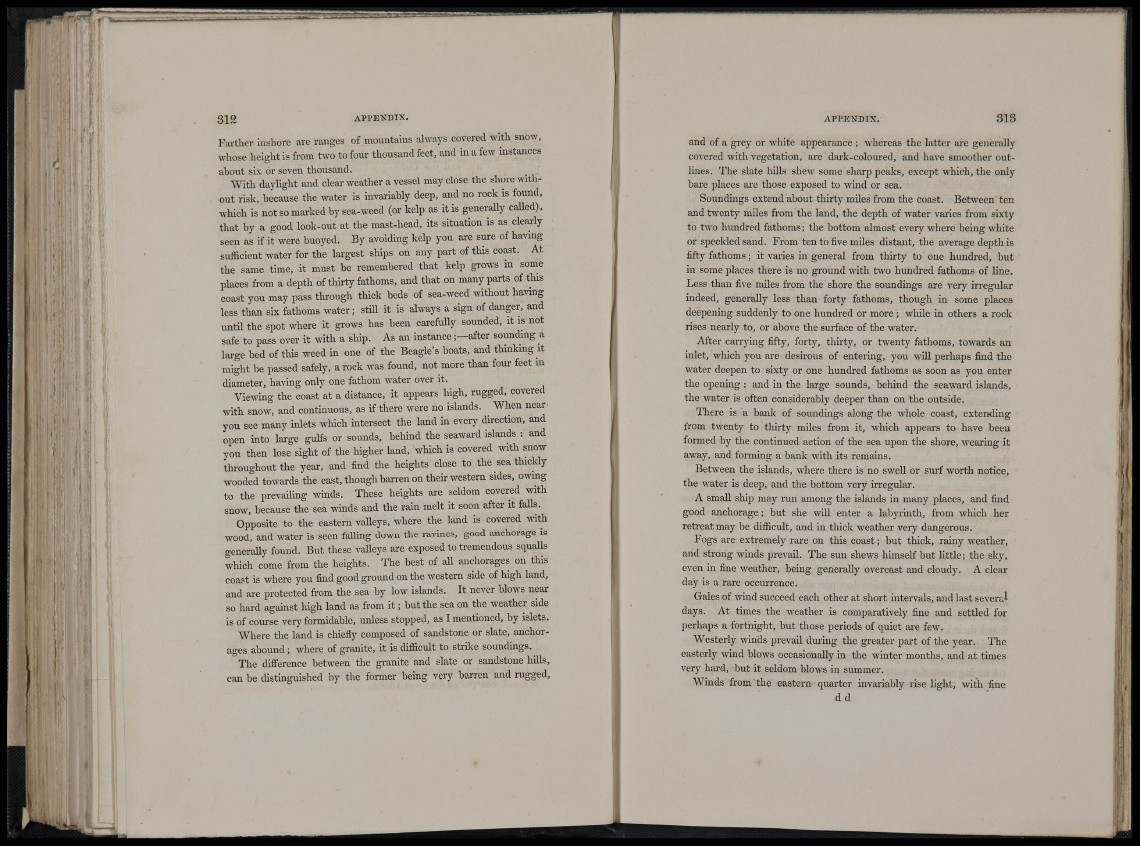
C . i M
:: ^ .ir
, : !!
f 1 .
'i!
! •/•
.' 1 •
1 •
Hi 1 " E>
• liti i i - ' ! "^' • ^w
:!.; f i i
:r J I!/ ):
rlilli.i
i'f
I f
ii!'- 1
l l
i I • -
>1
312 APPENDIX.
Farther inshove are ranges of mountains always covered with snow,
whose height is from two to four thousand feet, and in a few instances
about six or seven thousand.
With dayhght and clear weather a vessel may close the shore without
risk, because the water is invariably deep, and no rock is found,
which is not so marked by sea-weed (or kelp as it is generaUy called),
that by a good look-out at the mast-head, its situation is as clearly
seen as if it were huoyed. By avoicUng kelp you are sure of having
sufficient water for the lai'gest ships on any part of this coast. At
the same time, it must be remembered that kelp grows in some
places from a depth of thirty fathoms, and that on many parts of this
coast you may pass through thick beds of sea-weed without havmg
less than six fathoms water; still it is always a sign of danger, and
until the spot where it grows has been carefully sounded, it is not
safe to pass over it with a ship. As an instance ; - a f t e r sounding a
lai-ge bed of this weed in one of the Beagle's boats, and thmking it
might be passed safely, a rock was found, not more than four feet in
diameter, having only one fathom water over it.
Viewing the coast at a distance, it appears liigh, rugged, covered
with snow, and continuous, as if there were no islands. When near
you see many inlets which mterseet the land in every direction, and
open into large gulfs or sounds, behind the seaward islands : and
you then lose sight of the higher land, which is covered with snow
throughout the year, and find the heights close to the sea thickly
wooded towards the east, though barren on thehr western sides, owmg
to the prevaihng win<.ls. ITiese heights are seldom covered with
snow, because the sea winds and the rain melt it soon after it falls.
Opposite to the eastern vaUeys, where the land is covered with
wood, and water is seen falling down the ravines, good anchorage is
generaUy found. But these vaUeys are e x p o s e d to tremendous squalls
which come from the heights. The best of all anchorages on this
coast is where you find good ground on the western side of high land,
and are protected from the sea by low islands. It never blows neaiso
hard against high land as from i t ; but the sea on the weather side
is of course very formidable, unless stopped, as I mentioned, by islets.
Where the land is chiefly composed of sandstone or slate, anchorages
abound; where of granite, it is difficult to strilte soundings.
The difference between the granite and slate or sandstone hills,
can be distinguished by the former being very barren and rugged.
APi'KNDIX. 313
and of a grey or white appearance ; whereas the latter are generally
covered with vegetation, are dark-coloured, and have smoother outlines.
The slate hills shew some sharp peaks, except which, the only
bare places are those exposed to wind or sea.
Soundings extend about thirty miles from the coast. Between ten
and twenty miles from the land, the depth of water varies from sixty
to two hundred fathoms; the bottom almost every where being white
or speckled sand. From ten to five miles distant, the average depth is
fifty fathoms; it varies in general from thirty to' one hundred, but
in some places there is no gi'ound with two hundred fathoms of line.
Less than five miles from the shore the soundings are very irregular
indeed, generaUy less than forty fathoms, though in some places
deepening suddenly to one hundred or more; while in others a rock
rises nearly to, or above the surface of the water.
After carrying fifty, forty, thirty, or twenty fathoms, towards an
inlet, which you are desirous of entering, you will perhaps find the
water deepen to sixty or one hundred fathoms as soon as you enter
the opening : and in the large sounds, behind the seaward islands,
the water is often considerably deeper than on the outside.
Tliere is a bank of soundings along the whole coast, extending
from twenty to thirty miles from it, which appears to have been
formed by the continued action of the sea upon the shore, wearing it
away, and forming a banlc with its remains.
Between the islands, where there is no swell or surf worth notice,
the water is deep, and the bottom very irregular.
A small ship may run among the islands in many places, and find
good anchorage; but she will enter a labyrinth, from which her
retreat may be difficult, and in thick weather very dangerous.
Fogs are extremely rare on this coast; but thick, rainy weather,
and strong winds prevail. The sun shews himself hut little; the sky,
even in fine weather, being generally overcast and cloudy. A clear
day is a rare occiuTence.
Gales of wind succeed each other at short intei-vals, and last severE.1
days. At times the weather is comparatively fine and settled for
perhaps a fortnight, but those periods of quiet are few.
Westerly winds prevail during the greater part of the year. The
easterly wind blows occasionally in the winter months, and at times
very hai'd, but it seldom blows in summer.
Winds fi-om the eastern quarter invariably rise light, with fine
d d